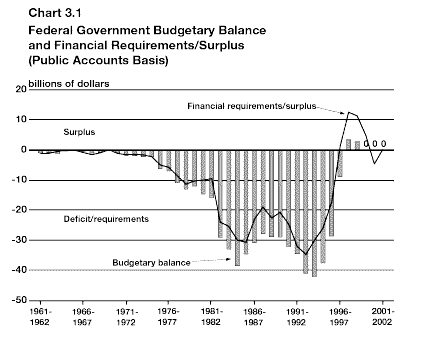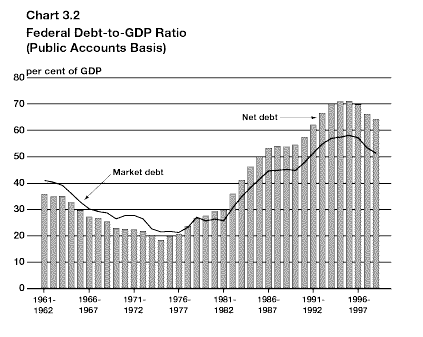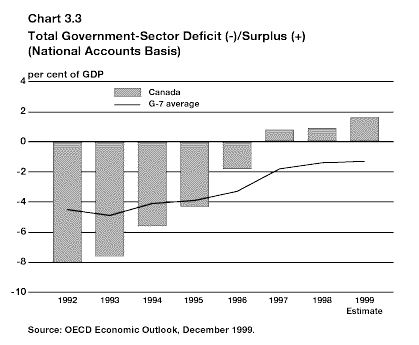
Budget Plan - Chapter 3

|
|
|
Maintaining Sound Financial Management |
| - Franšais - Table of Contents - Next - | |
The Government of Canada is now in a new fiscal era of budget surpluses that paves the way for further broad-based tax reductions and investments in key priorities. It is an era that hardly seemed possible in 1993-94 when the federal deficit reached $42 billion. High deficits and the resulting pressure on interest rates were pushing up the debt burden and depressing economic growth and job creation, which in turn further aggravated the debt burden. This crippling cycle was already hurting Canada’s standard of living, and left unchecked, it would have resulted in far worse consequences for the country.
With the support of all Canadians, the $42-billion deficit was eliminated by implementing a program of spending restraint and practising sound and prudent economic management. In 1997-98, the Government was able to report a budgetary surplus of $3.5 billion, its first since 1969-70 (Chart 3.1). In addition to eliminating the deficit and posting a surplus, the Government was able that same year to begin making substantial investments in access to knowledge and skills through the Canadian Opportunities Strategy to support economic growth.
The following year, in 1998-99, the Government not only recorded a second consecutive budget surplus of $2.9 billion, but also invested substantially in health care, knowledge and skills, and tax relief.
Financial results for the first nine months of this fiscal year clearly indicate that a balanced budget, or better, will be recorded for 1999-2000. This will mark the third consecutive balanced budget or surplus – the first time this has occurred in nearly 50 years.
This underscores the soundness of the Government’s fiscal strategy: using two-year rolling budget plans which are based on prudent planning assumptions backed by a Contingency Reserve, while adopting policies that support economic growth and job creation.
The Government is not prepared to risk a return to deficits. The benefits of maintaining sound public finances – sustained economic growth, more jobs and higher incomes for Canadians – will not be put at risk.

This budget continues with that strategy. It proposes a five-year tax reduction plan and major new investments to make the Canadian economy more innovative and improve the quality of life of Canadians. Furthermore, after accounting for these measures, the Government is committing to balanced budgets or better for 2000-01 and 2001-02. This will mark five consecutive years of balanced budgets or surpluses. Since Confederation, there have been only two other occasions when the Government of Canada recorded balanced budgets or better for at least five consecutive years – in the 1920s, and again in the late 1940s through to the early 1950s, the period of demobilization following World War II.
The combined federal, provincial and territorial government sector also recorded a small surplus in 1998-99, as the federal surplus of $2.9 billion offset the consolidated provincial-territorial deficit of $1.9 billion. This was a remarkable turnaround from 1992-93, when the combined government-sector deficit was $66 billion. Based on current plans and the commitment of all provinces and territories to balanced budgets, the total provincial-territorial deficit should continue to decline. Further information on the combined federal-provincial-territorial government-sector balance is presented in Annex 3.
The budgetary balance – deficit/surplus – is one measure of the Government’s financial situation. It is presented largely on an accrual basis of accounting. Therefore, it includes liabilities incurred by the Government regardless of when the actual cash payment is made.
Another important measure of the Government’s finances is the financial requirements/surplus – the difference between cash coming into the Government and cash payments made for programs and public debt charges during the year. Thus, unlike the budgetary balance, the financial requirements/surplus does not include any liabilities incurred by the Government for which no cash payment has been made during the year. The Government has recorded a financial surplus in each of the last three years – $1.3 billion in 1996-97, $12.7 billion in 1997-98 and $11.5 billion in 1998-99. Based on financial results to date this fiscal year, a financial surplus of $8 billion is expected in 1999-2000.
Financial requirements/surplus is broadly comparable to the measures of the budgetary balance used by most other major industrialized countries, including the United States. Among central federal governments within the Group of Seven industrialized countries (G-7), Canada was the first country to record a financial surplus this decade and only Canada, the United States and the United Kingdom are expected to continue to record financial surpluses over the near term.
With budgetary surpluses in each of the last two fiscal years, the stock of public debt has declined by $6.4 billion. More importantly, the federal debt-to-GDP ratio has declined each year since 1995-96. This ratio is generally recognized as the most appropriate measure of the debt burden, as it measures debt relative to the ability of the Government and the country’s taxpayers to finance it. In 1995-96, it reached a post-war peak of 71.2 per cent. By 1998-99, it had dropped to 64.4 per cent. With sustained economic growth and the Debt Repayment Plan, the debt-to-GDP ratio will continue to decline.
Although the deficit has been eliminated, the debt-to-GDP ratio is still too high, both by historical experience (Chart 3.2) and by international standards (Annex 4). Further reduction of the debt-to-GDP ratio remains a key objective of the Government’s fiscal policy.

Financial requirements/surplus provides a broad indication of the change in market debt actually outstanding and held by investors in the form of Government of Canada bonds, Canada Savings Bonds and Treasury bills. The Government retired a total of $16.4 billion of market debt in 1997-98 and 1998-99. Based on results to date, additional debt retirement will occur in 1999-2000, which could bring the total retirement to about $20 billion. This will provide ongoing interest savings. As a percentage of GDP, market debt has declined from a post-war peak of 58.2 per cent in 1995-96 to an estimated 48.5 per cent in 1999-2000.
When making comparisons with other countries, adjustments must be made for differences in both the accounting practices and distribution of responsibilities among the various levels of government in each country. For international comparisons, the most appropriate measure is the total government-sector budget balance on a National Accounts basis. For Canada, the total government sector includes federal, provincial, territorial and local governments as well as the Canada Pension Plan and Quebec Pension Plan.
Canada’s budgetary position has gone from being among the worst in the G-7 in the early 1990s to the best today. In 1992, Canada’s total government-sector deficit reached a high of 8 per cent of GDP, compared to the G-7 average of 4.5 per cent (Chart 3.3).

Subsequent deficit reduction efforts by all levels of Canadian government resulted in a total government budget surplus in 1997 – Canada was the first G-7 country to record a surplus in the 1990s. The Organisation for Economic Co-operation and Development (OECD) estimates that Canada’s budget surplus reached 1.6 per cent of GDP in 1999, compared to an average deficit of 1.3 per cent among G-7 countries (detailed international comparisons are provided in Annex 4).
| Budget 2000 Publications | Budget 2000 Main Page |